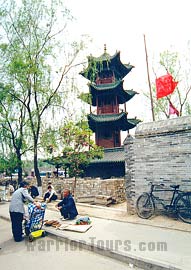 The Yuan Dynasty was established by the Mongolian ruler, Kublai Khan (1215-1294) and Emperor Shizu in 1271 with Dadu (currently Beijing as the capital). Almost a hundred years later, it was ended by the Ming Dynasty (1368-1644) in 1368.
The Yuan Dynasty was established by the Mongolian ruler, Kublai Khan (1215-1294) and Emperor Shizu in 1271 with Dadu (currently Beijing as the capital). Almost a hundred years later, it was ended by the Ming Dynasty (1368-1644) in 1368.
![]() Establishment of Yuan Dynasty
Establishment of Yuan Dynasty
In the 12th century, a notable leader of the Mongolian people named Tie Muzhen, (grandfather of Kublai Khan) appeared on the Mongolian Plain. Then, he was selected as the Khan (monarch) of the Mongolian people in 1206 and was respected as 'Genghis Khan' (ruler of the world) by all the tribes. Under the leadership of Tie Muzhen, the Mongolian people gradually developed into a considerable force in northern China. It destroyed the Western Liao Dynasty (1132-1218) and the Western Xia Dynasty (1032 - 1227) in 1217 and 1227, respectively. Unfortunately, Genghis Khan died of an illness on the march. Ögödei (wokuotai), his third son, took over the position of Khan in 1229. Qubilai (Hu Bilie) succeeded as Khan. Ögödei's army had conquered the Gaoli Dynasty in 1231, eliminated the Jin Dynasty (1115-1234), occupied Moscow in 1237, and then defeated the German army by attacking Poland and Hungary in 1241. His victories shocked European nations. Succeeding Ögödei, Möngke (Mengge) was chosen as the Khan in 1251. Then, Möngke destroyed Dali State in 1254, occupied Baghdad, capital of Arab Empire (632–1258), in 1258, eliminated Abbsid Dynasty (750-1258) in 1258, and then took Damascus in 1259.
After Möngke's death, his brothers, Qubilai (Hu Bilie) and Arigh Böke (Ali Buge) began to fight for Khan. In March of 1260, Arigh Böke ascended to Khan in Kharkhorum, capital of the Mongolian State, under the support of the Mongolian people. At the same time, Qubilai proclaimed himself Khan under the support of some knowledge ministers of central China and some Mongolian royal kings in Kaiping (Duolun District of Inner Mongolia today). When Qubilai deviated from the tradition to make himself Khan and carried out the policies of the Han, this caused strong discontent from Arigh Böke and the Mongolian people. After four-years of civil war, Qubilai defeated Arigh Böke in 1264, but most Mongolian nobles refused to profess loyalty to Qubilai. As a result, Qubilai's regime only covered China and part of the Mongolian area.
In 1271, Qubilai changed the state title to 'Yuan'. In 1276, the army of the Yuan Dynasty conquered Lin'an (Hangzhou), capital of the Southern Song Dynasty (1127 - 1279) and reunified China.
![]() Development of the Yuan Dynasty
Development of the Yuan Dynasty
After the unification, Qubilai continued to invade other states, enlarging his territory to include the Gaoli Dynasty, Burma, Taicheng and An'nan (northern Vietnam). Meanwhile, the Yuan Dynasty also made progress in politics, economy, culture and science.
![]() Territory
Territory
At its peak, the Yuan Dynasty's territory covered a total area of over 12 million square kilometers (120 million hectares), stretching as far north as Mongolia and Siberia while traversing to the South Sea. To the west, it included Tibet and Yunnan while it encompassed eastern Xinjiang in northwest and bordered Khingan Mountains and Okhotsk Sea in the northeast.
![]() Politics
Politics
In the beginning of the Yuan Dynasty, Qubilai practiced Han Policy and adopted the ruling system of central China to rule his people. Later, he resumed the system of 'Imperial Exam' (a kind of examination system in ancient times, through which officials were examined and selected.), although the quota was limited. He respected Confucius and made Cheng-zhu School of Confucianism as the official thought of the Yuan Dynasty. However, the Han Policy wasn't implemented thoroughly. The rulers of the Yuan Dynasty divided the people into four grades: the Mongolians, the Semu (people in the western Xia Dynasty and Western Regions), the Han (people originally ruled by the Jin Dynasty) and the Nan (People originally ruled by the Southern Song Dynasty). Under this system, the Hans inherited an inferior social status, precipitating a small revolt with minority groups in the south that subsequently failed.
![]() Economy
Economy
Originally, the productivity of the Mongolians was very poor because of their long-term nomadic life. With the rule of the Qubilai, the Yuan Dynasty adopted agricultural production and animal husbandry which increased productivity significantly. In addition, the Yuan territory extended into West Asia, which increased communication between China and Europe. The development of the economy also advanced handicrafts and other commercial industries. With the popularity of water transport and paper money, commercial industry became very prosperous creating a Yuan Dynasty that became one of the richest countries in the world.
![]() Culture and Science
Culture and Science
The Yuan Dynasty also made great achievements in culture and science, particularly in astronomy. Dramas and novels were also produced in great number, and a group of dramatists came forth with Guan Hanqing as the representative. Yuan Qu (Lyric Song), Tang Poem and Song Poetry all became part of China's cultural heritage.
![]() Fall of Yuan Dynasty
Fall of Yuan Dynasty
Later, rulers began continuously collecting all kinds of taxes from the people, resulting in untold suffering. Subsequently peasant uprising spread throughout China, among which Zhu Yuanzhang was the strongest. From the year 1356 to 1359, Zhu Yuanzhang gradually obtained half of the Yuan Dynasty's territory in the south of the Yangtze River . From the year 1367, Zhu Yuanzhang began to go on northern expeditions with the help of Generals Xu Da and Chang Yuchun, and captured Dadu of the Yuan Dynasty in 1368. In the same year, Zhu Yuanzhang proclaimed himself emperor in Jiankang (currently Nanjing)establishing the Ming Dynasty and a new era.

